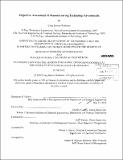Objective assessment of manufacturing technology investments
Author(s)
Rothman, Craig Jeremy
DownloadFull printable version (9.587Mb)
Other Contributors
Leaders for Global Operations Program.
Advisor
Robert T. Haslam and Roy Welsch.
Terms of use
Metadata
Show full item recordAbstract
Amgen is a biotechnology company with manufacturing plants throughout the world. New manufacturing technologies are constantly being developed and implemented in order to address cost, quality, regulation, and competitive forces. However, deciding on the technologies to implement is difficult because there is much uncertainty and the regulatory constraints of old products need to be balanced with the need of manufacturing flexibility for new products. Interviews were conducted with executives at Amgen and other biotechnology companies to understand their current decision-making processes and no gold-standard decision-making process emerged. The current process at Amgen is a business case along with net present value (NPV). However, the process has been found to be somewhat biased and decisions are often made on gut-instinct and excitement. In addition, the business case often fails to capture some of the more subjective, intangible elements of new technologies. Therefore, a technology decision-making framework based on the Analytic Hierarchy Process (AHP) is introduced. The AHP is an objective, group decision-making approach. For usability and sustainability, commercial software from Expert Choice was used in case studies to validate AHP as a decisionmaking approach within Amgen. One case study looked at options to upgrade a clinical manufacturing facility. An AHP model was analyzed simultaneously with a typical business case and NPV analysis. The AHP model allowed management to understand the more subjective areas where the options differed and therefore was a suitable approach that added value. Another case study was performed looking at choosing a standardized drug substance container where five previous analyses had been performed, but no decision made. The AHP model allowed the different criteria to be combined in one model with cross-functional input so that management could make a holistic decision. The AHP approach had many benefits and using commercial software made the process easier for users and allowed for a more sustainaible process within Amgen.
Description
Thesis (M.B.A.)--Massachusetts Institute of Technology, Sloan School of Management; and, (S.M.)--Massachusetts Institute of Technology, Dept. of Chemical Engineering; in conjunction with the Leaders for Global Operations Program at MIT, 2012. Cataloged from PDF version of thesis. Includes bibliographical references (p. 65-67).
Date issued
2012Department
Leaders for Global Operations Program at MIT; Massachusetts Institute of Technology. Department of Chemical Engineering; Sloan School of ManagementPublisher
Massachusetts Institute of Technology
Keywords
Sloan School of Management., Chemical Engineering., Leaders for Global Operations Program.